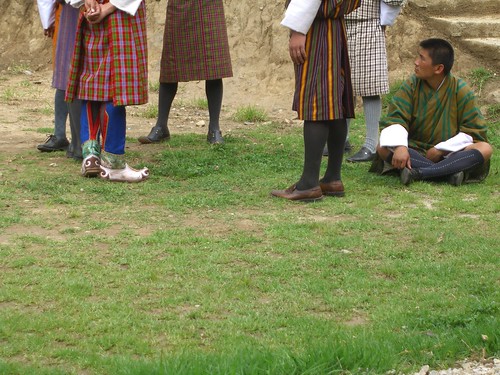
Day 5
The next morning we came down for
breakfast and noticed the fruit was peeled. Actually, I really
noticed this when breakfast was brought for another table in the
restaurant and their fruit wasn't. I never said anything, but they
had noticed my peeling my fruit the day before. Awesome.
We were off for the Art School. As a
part of the active effort to preserve the culture, all the
traditional crafts are supported by a training program here;
carpentry, embroidery, metal working, painting, and doll making.
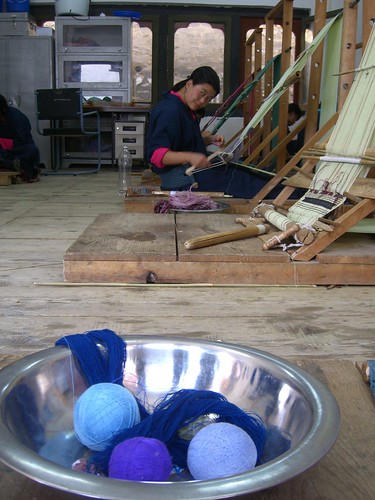
We also went through the Folk Heritage
museum, which had an example of a traditional Bhutanese home,
complete with artifacts of daily life. It was groovy, but our mojo
got a little messed up by a tour of Chinese “VIPs” (and it would
seem their wives, cousins, next door neighbors etc.) who not only
ignored the “no picture” signs but also happily bypassed the
little ropes and “no touching” signs to pose in the display
holding the various kitchen/farm/religious implements. Like a German
in a uniform, a Chinese bureaucrat with a “VIP” card is an object
to fear and loathe.
One cool thing about the Bhutanese
homes. They all have a prayer room, a space set apart with a small
shrine. This room usually has nothing but an altar and cushions, and
one chair. The chair is not, however, for the patriarch or any
member of the family. The chair (really a raised dais with a cushion
for sitting in the lotus position) is reserved for monks of a certain
level. At special occasions a monk will visit the family to perform
rituals. Most of the time the monk will sit on a cushion to the side
of this chair (and the family on the floor). However, on very, very
special occasions (a few times in each lifetime for most people) a
more senior monk will be in attendance as well, and occupy the chair.
So nearly every home has a piece of furniture that by tradition gets
used only every few years. And it's not like a box of Christmas
decorations that are stuffed in the garage or the attic for 11 months
of the year – the prayer room is used frequently by the family
(perhaps several times a day by a pious family) but the chair will
always be left vacant.
We were quick through both of the Folk
Heritage Museum and Art School, as we also needed to get over to the
city of Punakha. The road takes us up over a very high pass (4500
meters or so – basically the top of Mount Whitney) and back down,
also through another checkpoint.
En route is a big new temple, one
even Tashi hasn't been in yet it is so new, and a place where the
former queen built 108 stupas to protect the King and the army after
their campaign against Nepalese insurgents.

We were in the new temple for about
three minutes before getting shooed out – some VIPs were on their
way to see it.
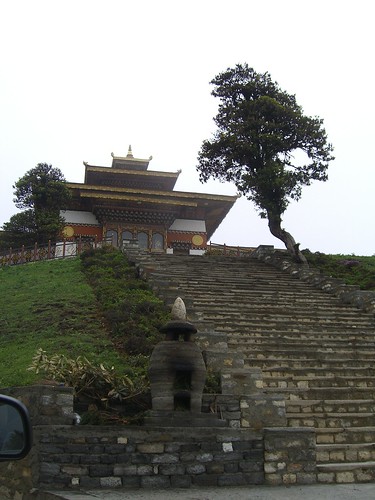
Technically, this is a family temple of the royal
family, and so when a prince, queen, or other royal wants to use it
it is closed to the public. Too bad, it's a very cool place. New,
and with many modern elements, like realistic faces on many of the
paintings, but still very much fitting to the traditonal aesthetic
and clearly a Bhutanese temple. Along the top of the walls in the
main chamber are murals dipicting the history of the Kings of Bhutan.
Outside (where we could still spend a few minutes) angels flew with
faces of Bhutanese children.

As we made our way back down the other
side of the pass we quickly pulled to the side of the road for a
motorcade heading uphill – the Prime Minister and two queens (the
King has four wives). Phubu quickly pulled off his hat, and he and
Tashi both bent their heads to look down as they drove past. So, I
guess that was the VIP. A couple of days earlier we had pulled left
(slow lane – they drive on the left here) and let a big SUV pass
us. Then too Phubu had quickly taken off his hat. It was a prince
driving himself (you can tell by the license plate).
Sadly the weather at the pass was foul
and we didn't get the vista of giant himalyan peaks in the distance.
We tried to wait it out and eat near the peak, but no dice, instead a
mix of rain and snow. In eight days this was pretty much the only
time the weather caused us any real trouble – despite what is
supposedly the “wet season”.
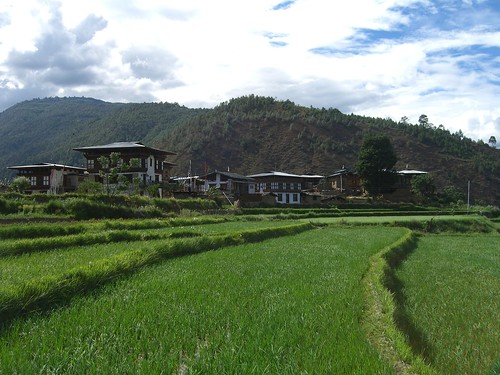
The climate and flora on this side of
the pass is very different, on account of the lower altitude (only
1200 meters or so). They call it “semi tropical”. I don't know
about that, but it was hot.
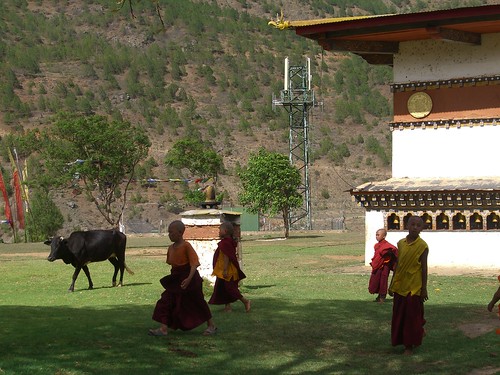
After lunch our next stop was “The
Temple of the Divine Madman”. They love this guy here. There
are all sorts of wild stories about him – apparently when he wasn't
battling demons he was drinking and chasing skirts. Among the
stories of debauchery are tales that he bedded his own mother. But
whatever, I guess battling demons gets you lots of credit, cause he
is a HUGE deal. Especially in this region. Apparently he figured
out that evil spirits are scared off by his... well you know. So
people will buy a wooden... and hang it under the rafters of their
houses. But for some folks, just in case, they seem to augment this
by painting phalluses on the outside of their homes (which double as
fetility charms). Susan just loved this, and would have filled an
entire roll of film with photos of this if I had let her.
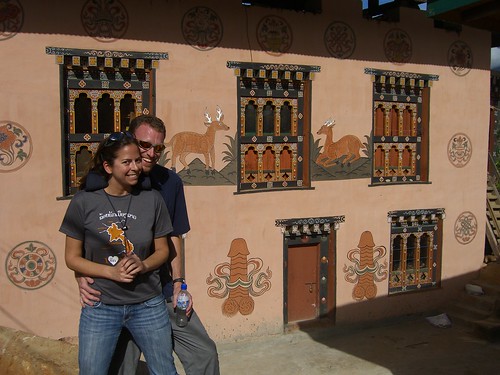
The giant wooden phalluses continued
after we got to the temple. As Tashi explained on the walk through
the rice fields that surround the temple, people come here if they
are having trouble conceiving. A special offering and a special
blessing from the resident monk and many people find success. Susan
asked if there was a reverse charm, maybe one that provided a couple
of years protection?

This got us into a discussion of sexual
politic, comparing American and Bhutanese ways. Tashi was surprised
to learn we weren't married, and really surprised to learn that we've
only known each other since November. I hadn't realized he'd missed
this, but sometimes things get lost in translation.

Anyway, Bhutanese often practice
polygamy, though it is slowly losing favor. Interestingly, this is
not only men with many wives, but some wives with many husbands.
Typically, the multiple spouses are siblings. The King, for example,
has four wives, all sisters. But even a farmer's daughter might
marry four brothers. The reason for this is to preserve the wealth
and property. While not a hard and fast rule, husbands typically
move into the homes and farms of their new wives. For a wealthy
landowner, dividing his land among several offspring is not such a
big deal, but for those with a more marginal bequeathment polygamy
lets them keep the parcel intact for another generation. One
daughter with four husbands means a single parcel, worked by four
able-bodied men. Four daughters with one husband yields the same
result (although multiplying the challenge for the grandkid
generation). This practice is slowly being discouraged as Bhutan
tries to modernize certain ways. A minister once challenged the King
if he thought he was setting a good example with his four wives. His
retort was that any young men should just look to him to see a great
example of why not to.
The walk through the rice paddies was
beautiful and bucolic, with folks cutting weeds and planting rice by
hand. Our hotel sat high on a hillside overlooking Punakha.

We had
a nice little balcony, where I wrote for a few hours and we watched
the sunset. The whole country is like a million postcards stiched
together.
